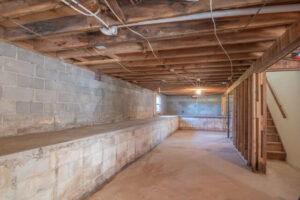When you don’t fix a water main line leak right away, it can cause damage that ranges from annoying to downright serious. We recently wrote an article on 5 Signs You Have a Water Main Leak That Needs Your Attention ASAP, but the signs we talk about in that post are far from the only indications that your water main is leaking. To help you get a better idea of how this problem can present itself, here are five more signs of a water main leak in your home. Signs of a Water Main Line Leak You Have Poor Water Pressure Low water pressure is a nuisance when you need to take a shower or wash the dishes after dinner. It’s possible that the problem is simply a matter of multiple people using the water system simultaneously. If you regularly experience poor water pressure, however, the problem might be more serious than someone else running the water at the same time as you. It could be a water main line leak that is allowing water to escape before it reaches your home. Your Water Bill Was Unusually High Last Month When you have a water leak, you could end up … Continue reading 5 More Signs of a Water Main Line Leak That Requires Immediate Attention

5 Signs You Have a Water Main Leak That Needs Your Attention ASAP!
If left unattended for even a short amount of time, a water main leak can cause serious damage to your home and the surrounding property. While many homeowners are well aware of the structural and cosmetic havoc that a broken main water line can cause, lots of people may be surprised to find out that it can lead to crumbling roads and driveways, flooded yards, and possibly even damage to surrounding homes. If you want to avoid such an expensive outcome, pay attention and look for these five signs of trouble. Signs of a Water Main Leak Standing Water on Your Lawn One of the first signs that you need to look out for is excess water on your lawn. You may have noticed that your grass is greener in certain areas. This could be because your leaking water main is feeding straight into your yard. You should be careful if you see this type of evidence—a damaged foundation isn’t the only thing to be worried about. This type of problem can actually lead to sinkholes because of erosion if you don’t catch it quickly. Water Accumulating in the Street Keep your eye on the road if you suspect you … Continue reading 5 Signs You Have a Water Main Leak That Needs Your Attention ASAP!

Emergency Basement Flooding: Who to Call, What to Do, and What to Expect
Have you ever experienced an emergency basement flooding? If not, you probably don’t know what to expect. Here are some tips. For homeowners, there might not be anything more frustrating than a flooded basement. Whether the flooding is caused by mother nature or a burst pipe, not only can it cause lots of damage that ends up costing an arm and a leg, but also it can be dangerous if you don’t know what you are doing. Want to ensure that you are ready for a flooded basement? Read on to learn who you should call, what you should do while you wait for help, and what to expect once help arrives. Who to Call after an Emergency Basement Flooding Perhaps the most important thing to do following a flooding incident is to take extra precautions until a professional can arrive. A flooded basement is often an electrical hazard and setting foot in the water can lead to serious injury and even death if you are not careful. It’s best to contact an electrician if you cannot safely turn off the power to your home. If your circuit breaker is located in the basement, wait until you know it is … Continue reading Emergency Basement Flooding: Who to Call, What to Do, and What to Expect

What Is a Plumbing Emergency? 4 Examples that You Never Want to Experience
In an emergency, you want to know that you can rely on your plumber to get the job done. A good plumber knows what to do—and how to do it fast—during a plumbing emergency. What is a plumbing emergency? Keep reading to learn when you should call a plumbing expert ASAP. As the name suggests, a plumbing emergency is an incident during which the plumbing in your home or business malfunctions, often causing serious damage, or at least having the potential to cause it. It does not take long for a little bit of water to do a lot of damage to a building’s flooring, walls, ceilings, and even foundation. A plumbing emergency usually has a few distinct characteristics: Water is leaking from an undefined source. Water is coming from a visible source but can’t be stopped without professional help. The leaking water has caused or has the potential to cause extensive damage. Hazardous waste or materials are present. Your basement doesn’t need to be flooded to warrant a call to an emergency plumber. What is a plumbing emergency? These four examples answer this critical question. Leaking or Burst Pipes Leaky pipes are one of the most common examples of … Continue reading What Is a Plumbing Emergency? 4 Examples that You Never Want to Experience

How to Test Water Pressure in Your House: Everything You Need to Get Started
When was the last time you tested your home’s water pressure? Never? If you have given little to no thought to learning how to test water pressure in your house, you might want to reconsider. Here is what you need to know. Too much water pressure and you could damage your plumbing. Too little and you can’t take a comfortable shower. In some cases, you may not even realize that your pressure is not what it should be, but that problem is easily fixable with a few simple steps. If you have ever wondered how to test water pressure in your house, these tips are for you. The Shower/Toilet Test Have you ever noticed how the water pressure changes while you are showering when someone else flushes a toilet? If you have, you might want to take a closer look. Turn on your shower and watch what happens when you flush the toilet. Does the pressure drop significantly while the toilet is refilling? If so, it might be time to call a plumber to diagnose the problem. Buy a Pressure Gauge If you do not notice anything when you try the shower/toilet test but you still suspect you have a … Continue reading How to Test Water Pressure in Your House: Everything You Need to Get Started

